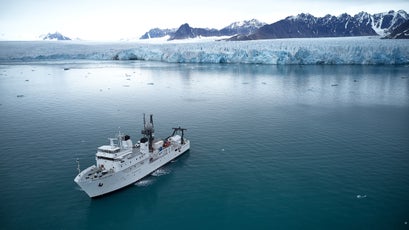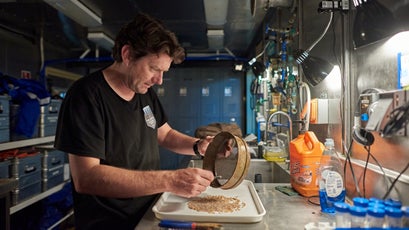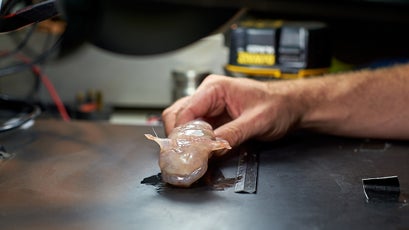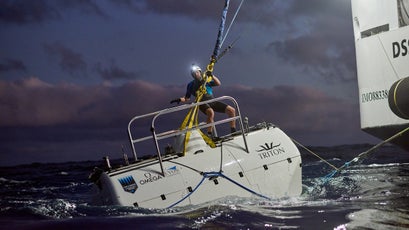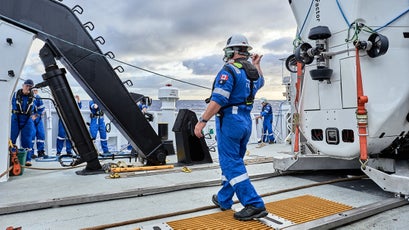One Man’s Wild Quest to Reach the Bottom of Every Ocean
Multimillionaire Victor Vescovo committed himself to one of the world’s craziest remaining adventure quests: to reach the deepest points in every ocean. What does it take to get there? A radically high-tech, $30 million Triton submersible, a team of crack engineers and scientists, and one very gonzo explorer.
New perk: Easily find new routes and hidden gems, upcoming running events, and more near you. Your weekly Local Running Newsletter has everything you need to lace up! .
It was a Sunday in Tonga, so the kingdom’s business had come to a halt. Stores were shuttered, traffic was quiet, even the airport was closed. King Tupou VI strolled out of his oceanfront palace and down the main street of Nukualofa, capital city of the island of Tongatapu, to attend church along with the rest of his South Pacific nation. Men wore their best sarongs; women wore taovalas—coconut-fiber aprons—over long dresses. The scene was all very ordinary except for one thing, and it was visible from the palace’s front lawn: a moored at the pier, bristling with heavy cranes, stacked with high-tech equipment, and carrying a mysterious $30 million cargo.
“Welcome to the good ship Pressure Drop,” said Rob McCallum, who stood on deck in khaki shorts, river shoes, and a polo shirt emblazoned with the emblem of the , a black shield bearing the Latin phrase In Profundo: Cognitio (“In the Deep: Knowledge”). A former New Zealand national park ranger who grew up in Papua New Guinea, 54-year-old McCallum is a legendary expedition leader. , some of which happen to be underwater, like the wreck of the Titanic. Five Deeps, however, was something even more extreme: a global mission to dive a manned submersible to the deepest point in the Atlantic, Pacific, Indian, Arctic, and Southern Oceans. This had never been done before—which is exactly why McCallum’s client, Texas businessman Victor Vescovo, had set out to do it.
If you were to draw a Venn diagram of people who want to dive seven miles underwater, people with the skills to test-pilot a deep submersible, people with the means to fund the most technologically advanced ocean expedition in history, and people willing to devote several years of their life to such an expedition—you wouldn’t find many names in the middle. But Vescovo qualifies on every count.
His résumé is unusual. As a student, Vescovo earned degrees from Stanford (political science and economics), MIT (defense and arms-control studies), and Harvard (MBA). At 53, and sits on the boards of ten companies. He is the 12th American to have completed , standing atop all of the Seven Summits and skiing to the North and South Poles. (On Mount Everest, he survived what he calls a “minor avalanche” in the Khumbu Icefall.) He’s made millions reinventing industrial processes; he pilots his own Embraer Phenom jet and Eurocopter 120 helicopter. He’s conversant in seven languages. His proficiency in Arabic came in handy during his 20 years as a U.S. Navy Reserve intelligence officer with top-secret clearance, especially right after 9/11. For relaxation, Vescovo studies military history, inhales science fiction, flies rescue dogs to new homes in his jet, and retreats to a workshop in his Dallas garage, where he makes fountain pens and tends to his collection of cars. He is not someone who approaches life in half measures.
According to Vescovo, the roots of his go-big-or-go-home philosophy can be traced back to age three, when he snuck into the family sedan, released the emergency brake, and rolled the car down the driveway into a tree. The resulting crash cracked his skull in three places, shattered his jaw, broke his hand and some ribs, and provided an early whiff of mortality. “I realized that every day is precious, and you may not get another one—best make full use of them,” Vescovo says.
Yet even by Vescovo’s standards, the goals he’d set for the Five Deeps were outlandish, ranking somewhere between launching into low orbit (easier) and decamping to Mars (harder). have walked on the lunar surface, but only to our planet’s deepest spot, known as the Challenger Deep. There are reasons for this. For one, it lies at the bottom of , a 1,500-mile-long, 43-mile-wide gash in the western Pacific seabed, near Guam. To reach it, you need to dive 11,000 meters: that’s 1.3 miles deeper than Mount Everest is high, in obsidian darkness, under pressures of 16,000 pounds per square inch.
Our knowledge about the ocean has long been concentrated in its uppermost waters, the top . If you see marine life and you can name it, odds are it swims in these shallows. But the epipelagic occupies only 5 percent of the ocean’s volume. It’s merely a ceiling: the real action takes place below. Traveling downward, you pass through the twilight zone (from 200 to 1,000 meters), the midnight zone (from 1,000 to 4,000 meters), the abyssal zone (4,000 to 6,000 meters), and then finally the , named after Hades, the mythical kingdom of the dead. These waters begin at 6,000 meters and pitch down into —the vast majority of which are located in the Pacific—like the inverted summits of towering peaks. The hadal zone is the earth’s most forbidding frontier. This realm is so hard to access that it has generally seemed prudent to send robots rather than people. But hard doesn’t mean impossible.
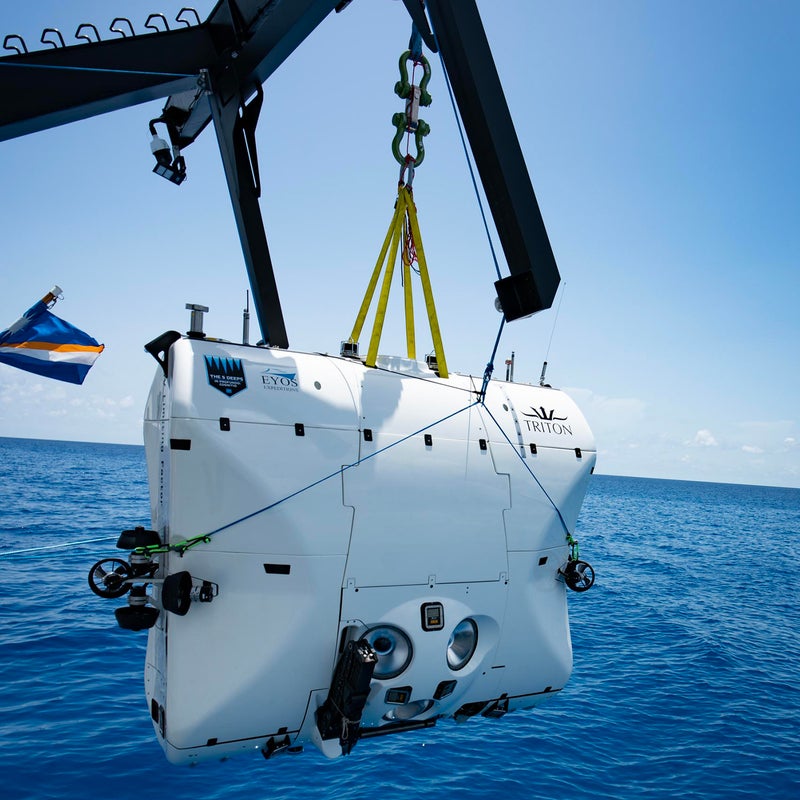
In 1960, the U.S. Navy sent Lieutenant Don Walsh and Swiss oceanographer Jacques Piccard to the Challenger Deep , a sort of underwater zeppelin loaded with iron pellets and 34,000 gallons of gasoline. Five hours after its submergence, the Trieste landed on the trench floor with a thud, stirring up clouds of silt that ruined the visibility. It was ironic to arrive at such an exotic destination and then fail to see it. But in their time near the bottom, Walsh and Piccard did glimpse something long and flat swimming away—a hint that Hades wasn’t a total wasteland.
The next half-century went by in the Mariana Trench without human visitation. Then, in March 2012, filmmaker James Cameron took the plunge in the Deepsea Challenger—a torpedo-shaped, lime-green vessel designed to carry only a pilot—becoming the first person to dive solo to the Challenger Deep. “In the space of one day, I’ve gone to another planet and come back,” . (Unfortunately, that was the last trip his submersible has made. He had donated it to Woods Hole Oceanographic Institution, and it was damaged during transport. It’s been in drydock ever since.)
To complete the Five Deeps, a submersible would need to be strong enough to withstand implosion in the hadal zone, but nimble enough to handle in rugged terrain; big enough to carry a pilot and a scientist, and reliable enough to trust with their lives, but light enough to be launched from a ship. Every wire and bolt and circuit board and battery on it would need to be fail-safe in corrosive salt water, under gargantuan pressures, and they would need to stay that way over time. This is such a tall order—and a proposition so expensive it makes Phenom jets look cheap—that no such vehicle existed. Until Vescovo commissioned one.
I hauled my duffel bag up the gangway and shook McCallum’s hand. The tropical sun blazed in a cloudless sky, glancing off a white hangar that stretched across the ship’s stern deck. Beneath this container, I knew, the most futuristic submersible ever built hunkered quietly, awaiting its next mission. Vescovo had named it Limiting Factor after an artificial intelligence in an Iain M. Banks science-fiction novel, and when I joined the ship, it had already made a run of successful dives. The Atlantic’s Puerto Rico Trench? Check. The Java Trench in the Indian Ocean? Done. The South Sandwich Trench in the Southern Ocean? Dicey but completed. And three weeks earlier, in May 2019, Vescovo had become the fourth person ever to touch down in the Pacific’s Challenger Deep, at 10,925 meters. The Five Deeps team had gone on to make four more dives in the Mariana Trench, for a total of five jaunts to the bottom of the earth within ten days. On one of those dives, the Limiting Factor became the first vessel to be certified by the , for “unlimited trips to full ocean depth.” On another, the expedition’s chief scientist, , of England’s Newcastle University, to personally visit the ecosystem he studied.
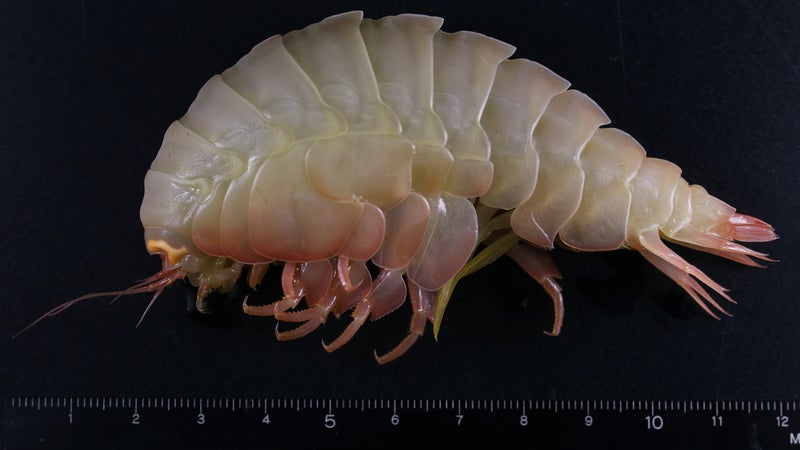
Now the expedition was headed out on its next Pacific quest: the first manned descent to the second-deepest spot on earth. Known as the Horizon Deep, this patch of Hades is part of the Tonga Trench. In 2013, a at 10,850 meters, less than 100 meters shy of the Challenger Deep’s record depth. But the world’s ocean trenches are tumultuous places. They’re formed by colliding tectonic plates, one plate driving another downward into the earth’s mantle. This process is called subduction, and it wreaks geological havoc. Some of its effects include rattling earthquakes, volcanic paroxysms, and submarine landslides, resulting in mega-tsunamis like the 2004 nightmare in Indonesia, which originated in the Java Trench, and the 2011 horror show in Japan. Such upheavals can change the seafloor topography as huge volumes of rock shift around. And the Tonga Trench is the liveliest subduction zone of all. Part of its at the unsettling rate of nine inches per year, causing swarms of earthquakes. On the off chance that some new, yawning chasm might be found, Vescovo wanted to take a closer look. “It’s well within the margin of error,” McCallum said, raising an eyebrow. He explained that we’d be leaving for the trench the following afternoon, timing our departure to skirt a major storm. “It’s going to be a little sporty.”
Later, after traveling with him, I would become familiar with McCallum’s signature facial expression: a kind of half smile, half smirk, both bemused and concerned, happy but always scanning ahead for trouble. By the time I arrived in Tonga, McCallum had spent two years planning, worrying, juggling, hiring, and scheduling, in addition to cajoling bureaucrats around the globe for the expedition’s necessary permits. “At the moment I’m dealing with 57 government entities,” he told me.
That was the easy part.
The Tonga Trench lies 178 miles southeast of Nukualofa, a passage that would take 18 hours. Four days were planned at the dive site, making it a weeklong round trip for 43 passengers and crew. While it was in port, the Pressure Drop buzzed with preparation. Vescovo had bought the ship—a Stalwart-class ocean-surveillance vessel designed for spying on Russian submarines during the Cold War—and outfitted it for the expedition. Its facilities included multiple offices, wet and dry science labs, a machine shop, a gym, a movie lounge, an infirmary, and satellite internet access that enabled Vescovo to conduct business from the middle of nowhere.
Patrick Lahey and I stood in the hangar next to , the submersible that he and his team had built after years of doodling on napkins, dreaming of the day when someone would come along with a large checkbook and a burning desire to dive below 6,000 meters. Lahey, 56, is a battle-tested guy with a lively sense of irreverence and a fast engine running between his ears. He’s the president of Florida-based and, like McCallum, a familiar figure in the world of ocean exploration. If you’ve ever seen a sub that looks like something George Jetson would drive—an aquatic spaceship in which passengers sit under a clear acrylic dome—you’ve seen Triton’s handiwork. : it’s the Apple of submersible design.
Even so, the Limiting Factor was a challenge of a different magnitude. It is to shallower-diving submersibles what the Space Shuttle is to a Cessna. I looked up at the sub: at 12 feet tall and 12.5 tons, it loomed over us. To me it looked like a giant padded envelope, white and square, with tapered edges. Most of its bulk consists of a highly specialized syntactic foam—made of tiny ceramic spheres suspended in polymer resin—the only material able to provide buoyancy while remaining uncrushable. “This is a perfect titanium sphere,” Lahey said, pointing to the pressure hull near the bottom of the sub, the five-foot-diameter cockpit where Vescovo and sometimes a passenger sit in padded leather seats. (It’s Vescovo’s custom to do the first descent alone in every new location, but after that he often brings another team member along on his dives.) The titanium is three and a half inches thick. In the deepest ocean trenches, the metal orb would be subjected to pressures equal to 292 fueled and fully loaded 747 jumbo jets stacked on top of it. The sphere’s three acrylic view ports gave it the appearance of a chubby alien’s face.
“I first met Victor four years ago,” Lahey recalled. “He said, ‘Would you build me a sub that will take me to the bottom of the ocean?’ A sub that would carry him—he didn’t care if it had view ports. I said, ‘I’m not doing that. I’ll build you a sub that takes two people, with view ports. It needs a hydraulic arm so it’s a legitimate tool for science. And it has to be certified, not a one-hit wonder, but a sub that can do thousands of dives to hadal depths and will change our relationship to the deep ocean.’” He smiled. “After all, it’s not just about getting down there. It’s about what you can do when you get down there.”
Over the past year, the Five Deeps team had been doing a lot: Horizon Deep would be the Limiting Factor’s 26th dive. All that remained to complete the expedition were this depth check of the Tonga Trench and the Molloy Deep in the Arctic Ocean (and a few dives on the Titanic by Vescovo and Lahey en route to the Arctic, because why not?). It was all going smoothly now, but for Lahey and his crew it had been a wild ride, with plenty of white-knuckle moments. There was the dive in the Southern Ocean when Vescovo’s communications systems failed and the weather closed in as he surfaced in the gloom among icebergs. On the next launch attempt the seas were pitching, and as the sub was lowered into the water, it swung like a wrecking ball into the stern of the ship. Then there was the dive in Challenger Deep when the Limiting Factor ran out of battery power on the bottom. And it was nobody’s idea of a good time when the sub’s $350,000 hydraulic arm fell off on a dive, sank into the Puerto Rico Trench, and had to be replaced. Through all this, Lahey remained undaunted. Thirty-eight years spent working as a commercial diver, submersible pilot, and submarine manufacturer had taught him that the ocean makes its own rules. “I’m a glass-half-full kind of guy,” he said. “You have to be optimistic or crazy or a little bit of both to do this, because I know there are easier ways to make a living.”
Vescovo arrived on board the next morning, coming into McCallum’s office with a gust of energy so intense that I wondered if it might knock the skull and crossbones flag off the wall. He is a slender, athletic man, six feet tall, with ice-blue eyes, blond hair that he wears in a ponytail, and a close-cropped silvery beard. Even now, in his fifties, he has the high-voltage stoke of a grommet. “So let’s see, I’m at the bottom of the deep, and I’m in my own submarine,” he said, laughing, when I asked him how things were going. “I can do whatever I want. I’m looking around, I’m seeing sea creatures—oh yeah, I’m having a blast!”
Vescovo’s enthusiasm is infectious, but there’s nothing giddy about it. His kid-like curiosity coexists with a mind that knows how to construct an aerospace factory and decipher raw intelligence on Al Qaeda. Lahey had described him to me as “a bit of a Vulcan,” equipped with fierce logic, but also “a friggin’ unicorn.” Both of these things are true.
At that particular moment, he was excited about the possibility of diving on the wreck of a . He’d been trawling online for new places to take the Limiting Factor. “K-278,” Vescovo announced. “It’s between the Molloy Deep and Tromsö, Norway. No Westerner’s ever gone down and photographed it. I’d have to bring a Geiger counter.”
Lahey, standing nearby, stared at him over the top of his reading glasses. “Diving next to a nuclear sub—what could possibly go wrong?”
“Oh, come on!” Vescovo urged. “It’d be awesome!” He turned to me. “When I started my Navy career, I was an intel guy. That was part of my job, hunting these things.”
Vescovo wandered into the dry lab, a mission-control area where the ocean-mapping team, the Triton engineers and technicians, and the scientists worked. LCD screens lined the walls, displaying high-resolution bathymetric maps of the Tonga Trench. The maps had been made with the expedition’s state-of-the-art sonar system, welded to the ship’s hull, on the trip from Guam to Tonga.
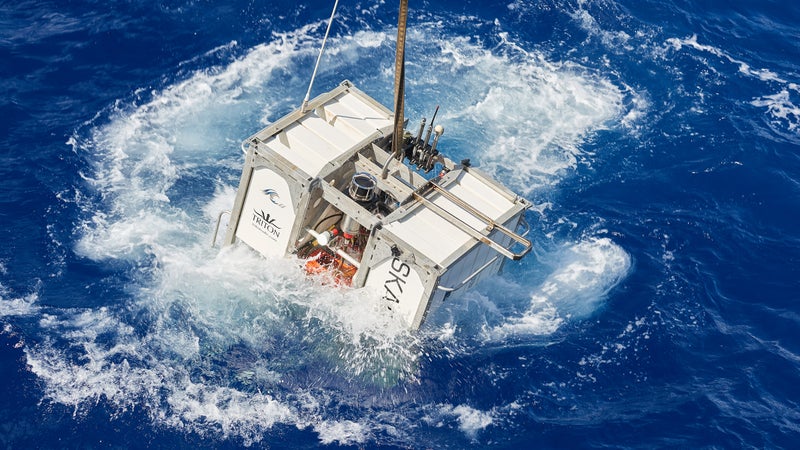
The trench was radically steep, with sheer walls of jagged rock. A ridge reared up in the center. “It will be the most dramatic deep we’ve seen so far,” Vescovo said, looking pleased. On the maps, the Horizon Deep appeared as a yellow dot, with its measurements confirmed: the Challenger Deep still reigned as the deepest trench. If Vescovo was disappointed by the news, he didn’t show it. The chance to make record-setting dives alone may have been his grail—he knew that Five Deeps could be perceived as “one man’s ego trip”—but along the way he’d become intrigued by the expedition’s scientific goals: to find out as much as possible about what was going on down there and then share that information. An impressive team of scientists had become involved; it included Jamieson, one of the top experts in hadal biology; geologist , an authority on subduction zones; and , from the British Geological Survey. The Tonga Trench is a wonderland of rock formation, earth processes, fluid circulation—a glimpse back into planetary deep time—and Vescovo planned to take Stewart on his second dive, to survey a thousand-meter wall near the bottom. “It would be nice to age that section of the crust,” Stewart noted. “Nobody’s actually done a transect of one of these walls. At all.”
On each dive, Vescovo invited eminent ocean explorers of past decades to join the ship. Captain Don Walsh, now 88, had come along to the Mariana Trench. was here for the Tonga leg. MacInnis’s medical specialty is the physiology and psychology of extreme diving, how the human body copes (or not) with exposure to depth. He’s led ten expeditions under Arctic ice and was an adviser to James Cameron. The French submersible pilot and former naval commander served as Five Deeps’ technical consultant; he’d been in charge of the Nautile, France’s 6,000-meter sub.
As a rule, deep-ocean research is difficult and expensive, and the field is badly underfunded. In 2018, NASA’s . That same year, the National Oceanic and Atmospheric Administration for ocean exploration and research. Every last crater on the moon has been named, but less than 18 percent of the ocean has been mapped with any kind of sharp detail. Precise depth measurements are especially hard to come by. The only way to measure ocean depth is with sound waves, which travel at varying speeds depending on water temperature, density, and salinity. Pinpointing depth over thousands of meters is a highly technical affair, and in most places in the ocean no one has even tried.
Before Vescovo could dive to the deepest spots in the Indian and the Southern Ocean, for instance, first he had to find them. He’d sprung for the ever made, and hired , a talented young ocean mapping scientist, to run it. (Ultimately, the Five Deeps maps will be donated to the General Bathymetric Chart of the Oceans, a UN body .) Triton had also built —untethered platforms the size of Smart cars and laden with scientific instruments, navigational equipment, cameras, animal traps, and bait—engineered to the same specifications as the sub. The landers took samples from the water column and enabled Jamieson to collect specimens everywhere the ship went, an unprecedented trove.
The first night at sea was bouncy, as predicted. “These are some pretty big swells,” Vescovo noted at breakfast the next morning, holding his plate to keep it from sliding across the table. “Well, the storm that’s generating them is a monster,” Lahey replied. “It’s covering half of New Zealand.” McCallum, a Kiwi, flashed his trademark smirk. “We call it winter.” I finished my toast and stood up, bracing myself between two tables. I was headed to the science lab to meet up with Jamieson and look at some deep-ocean creatures. “You’re gonna like Al,” Lahey said, grinning. “He’s a proper fucking dour Scotsman, miserable as the day is long. But he’s got a great sense of humor.”
Jamieson was in his office, a nook just big enough for a desk and two chairs. He was drinking coffee from his thermal mug, also known as the Goblet of Hades. No one had logged more time studying the trenches than Jamieson. He’s in his forties, tall, with a mop of dark hair and a tendency to glower even when cracking a joke. His uniform was a black T-shirt, baggy cargo shorts, and black steel-toed boots. I wanted to know more about what he’d found in the trenches, what the landers had brought up in their traps: critters were slurped into canisters and lured into wire-mesh boxes. “A lot of the usual suspects,” he said, and then brightened. “Oh, the Java Trench was quite good. I don’t know if you saw the video with the big sort of transparent thing with the dog head and the tentacles?” He pulled up a clip on his computer.
, at 6,000 meters. The background was ink black; the lander’s lights illuminated the foreground. Two metal bars reached into the darkness, holding a dead mackerel above a seafloor covered in soft brown sediment. A small fish hovered hopefully next to a white crinoid, a sea lily that resembled a wonky flower. “That’s a new species of snailfish,” Jamieson pointed out. “But look—” A ghostly figure appeared in the frame, sailing toward the bait. It really did look like a gelatinous basset hound head trailing a long tentacle. Inside the head there was a lot going on. It glimmered in pale shades of lilac, with twinkles of white and gold. “That’s so far scored highest on the weird-shit-o-meter,” Jamieson said, adding that it was a stalked ascidian, or sea squirt—albeit a species nobody had ever laid eyes on before.
The highlight reel continued, a parade of beings visiting the landers at various depths and locations. “Dumbo octopus at 6,000 meters—who would’ve thought?” Jamieson said of the deepest-ever sighting to that point. Dumbos are rare, primitive animals that propel themselves with the help of two flappy fins perched on their heads like cartoon elephant ears. (They’re also adorable.) A larger head jutted in from the side, round with small eyes, attached to a thick, snaky body. Jamieson identified it as a cusk eel. It wasn’t interested in the bait, he added, but in the other animals that had come for the bait. Cusk eels like to eat amphipods, white prawn-like crustaceans that populate the trenches in large numbers. Some amphipods are tiny, but others, known as supergiants, can grow up to 13 inches long. They’re ace predators: in one time-lapse sequence, we watched a cloud of amphipods devour a mackerel with such gusto that only the skeleton remained.
The ocean’s hadal zone is the earth’s most forbidding frontier. This realm is so hard to access that it has generally seemed prudent to send robots rather than people.
Earlier in his career, Jamieson had discovered the world’s deepest-dwelling fish, a snailfish species that could swim down to 8,200 meters. (.) “And there it is,” he said, pointing to the screen. Snailfish are popsicle-size, with semitransparent jelly bodies and fluttery fins, and they’re found in every Pacific trench. Despite their delicate appearance, they’ve got some gnarly capabilities. “They have two mouths,” Jamieson explained. With the first, they suck in amphipods. “But if you put an amphipod in your mouth, the first thing it’s gonna do is eat its way out of your head.” To solve that problem, the snailfish’s second, internal mouth consists of two grinding plates.
By this point in the expedition, Jamieson had made 63 lander deployments, filmed ten terabytes of video, and filled a freezer with animals that would all be donating their DNA to science. The genetic material collected on the expedition would be studied for years to come. “We’re looking at the population of the trench from the shallow end all the way to the deep end,” he said, gesturing to the screen. “And as you can see, there’s all kinds of things going on. The idea of the deep as this barren, lifeless place is just horseshit.”
On the morning of Vescovo’s first dive, the wind was blowing 20 knots and the ocean was choppy with swells coming from two directions and the sunrise had been a strange dark scarlet, but everything was a go for the launch. “Conditions are more challenging than we’d like,” Lahey admitted. “But they’re not the worst that we’ve had.” On the dive plan, McCallum had listed the day’s hazards: “Extreme depth. Tropical sun. Night recovery.” And then, at the bottom, highlighted in red: “Complacency.” “We’re coming off the massive high of Challenger Deep,” he warned. “This is the time karma will kick us if we’re not careful.”
I positioned myself on deck, out of the way of heavy machinery, and watched the Triton crew perform the industrial ballet required to launch the Limiting Factor. The process is undeniably dangerous, fraught with enough perils that it had once caused the deck operations manager, Kelvin Magee—a good-natured Canadian so strong and capable he’d been nicknamed the Kelvinator—to collapse from a stress-induced migraine. Winches whined as the hangar rolled back, and the sub was moved along tracks and then out of its cradle, pinning it against a bumper at the stern of the ship. Tim Macdonald, a 30-year-old mechanical engineer from Australia, climbed atop the sub, wearing a wetsuit, a safety vest, a helmet, and neoprene booties. He is the “swimmer,” a risky job that involves grappling with the sub’s hooks, lines, and straps during launch and recovery, and securing the craft so Vescovo can enter and exit. “I’m the most expendable,” he’d said jokingly. “That’s why they put me in.”
Now the Limiting Factor was suspended over the water, and Vescovo disappeared into the hatch. Slowly, the sub was lowered and moved away from the ship. Macdonald, still riding it like a bronco, unhooked the lines. It helped that he was a surfer: from my vantage point, I could see a big set rolling in. When he was finished, he leaped into the ocean and was picked up by McCallum in a Zodiac. The submersible was free to descend. I watched as it rocked in the waves, a white speck in the vast blue Pacific. Then it was gone.
I found Lahey in the dry lab, huddled over a laptop alongside Triton’s principal electrical design engineer, Tom Blades, a soft-spoken Brit in his thirties. The two would stay glued to this spot for the next ten hours, monitoring the sub’s movements using software Blades developed. “He’s doing roughly two knots,” Lahey said, “about a meter per second.” Every 15 minutes, Vescovo would transmit his depth and heading via acoustic modem, his voice coming in faintly but audibly with a burst of squeegee static.
Life on the ship was quiet while the dive was underway. People who’d been up all night preparing for the launch went off to their cabins to sleep. I felt restless and found it impossible to do anything but stare at the screens that charted Vescovo’s progress. It’s an odd thing to go about your day knowing that someone is miles below you in a world that nobody has ever seen. A small part of me was nervous for him. Every safety precaution had been taken, but the hadal zone is never 100 percent jeopardy-free. The worst-case scenario is known as catastrophic failure, which means that nothing—not the sub, not its passenger—comes back in solid form. Entanglement is another hazard, although that’s more of a concern around shipwrecks and cables. A cockpit fire or slow leak wouldn’t be good for Vescovo, either. Yet the odds of any of these scenarios happening were minuscule, and the larger part of me would’ve happily sold my lesser internal organs to trade places with him.
I could only imagine what it would be like to roam around Hades, the feeling of primeval solitude, alone in the ocean’s eternal night. That was Vescovo’s favorite part: he loved to dive solo. Understandably, there had been grumbling about going to such rarefied—and scientifically significant—places with an empty seat beside him. It didn’t make sense from an operations standpoint: it’s tricky for the pilot to simultaneously navigate and work the hydraulic arm. But Vescovo was firm about his choice. “It’s a materially different experience to be completely on your own in these remote, somewhat dangerous places,” he’d said. “It’s a more private experience. And there’s no greater feeling of freedom.” Vescovo would socialize as much as he needed to—on the ship he was always friendly and accessible—but his real soul food was independence. “I don’t think it’s a surprise to anyone that I’ve never been married,” he said.
Just before one o’clock, after a four-hour descent, Vescovo touched down in the Horizon Deep. “Life support good,” he relayed, his voice warbling in and out on the modem. “At bottom. Repeat. At bottom.” “Roger, L.F.,” Lahey responded. “Understand, depth one-zero-eight-one-seven meters. Life support good. On the bottom. Congratulations.” A cheer went up; everyone’s shoulders relaxed. But we also knew that the dive was far from over. Anything could happen. And 15 minutes later, it did.
After he landed on the seafloor, Vescovo had set out across the trench to pick up rock samples and deposit them in one of the landers. But he noticed that the sub’s batteries were draining fast. He shut down some systems and tried to figure out why he was losing power, but nothing was obviously wrong. Continuing on, he arrived at a slope where slivers of rock poked through the sediment. When he tried to run the manipulator arm, it gave him a voltage failure: not enough juice. By that point, he’d spent two of his three hours of bottom time. He decided to head back up.
Later it was discovered that water had breached an electrical junction box outside the hull, causing what Lahey described as “a sustained high-current event.” In other words, an electrical fire, though there couldn’t be actual flames at that depth. The box itself was scorched and melted and looked like it had been through a war. Lahey and Blades examined it for a long time. “It’s a difficult one,” Blades said, frowning. “There’s so much damage that we can’t see what the original cause was. There’s a seal that could’ve leaked slightly, but that seal’s long gone now. We just need to rebuild it.”
“Tom’s unflappable,” Lahey said. “Unlike me.”
Blades smiled drily. “I’m screaming inside.”
The submersible is designed so that failures are isolated, with triple redundancies and backup safety systems—Vescovo was never in imminent danger. But the repairs would take 48 hours, which meant there was no time for a second dive. If we waited out here, the storm would be upon us; 30-foot seas were forecast. The weather window had closed.
When the ship returned to Nukualofa, we had a sunset barbecue on the top deck that turned into a raucous party lasting late into the night. The celebration was due: over the past six weeks, the team had executed six dives below 10,000 meters, with everyone brought back safely. It was a feat that had never been accomplished—or even attempted—before.
I’d spent the days since the dive pestering Vescovo for details of what he’d seen in the deep, what thoughts had gone through his head, even what he’d eaten in the sub (a tuna sandwich, chips, and a Diet Coke). When I asked him how it felt down there, he described it as totally peaceful. “Once you go down below 500 meters, it’s a very different world,” he said. “It is quiet. It’s very dark, very calm. You could have a raging hurricane above you and you wouldn’t know it. In that respect, it’s almost an embrace.” He told me that each trench had its own personality: The Puerto Rico Trench was wide and flat at the bottom, thick with sediment and rafts of sargassum seaweed, and not especially lively at a glance. The Southern Ocean offered more scenery. The trench was rockier; he’d flown over the remnants of a volcanic eruption. The Mariana Trench emanated a strong mystique. He’d passed through an area of undulating dunes and fissures in the seafloor tinged yellow by sulfur deposits. In the Challenger Deep, he was met by a swimming sea cucumber. The Java Trench was enthralling: its steep walls were carpeted in ochre, cobalt, and orange bacterial mats, and there was evidence of underwater landslides. But Tonga? Vescovo wasn’t a fan. “This is the eeriest, most hostile place I’ve seen so far.”
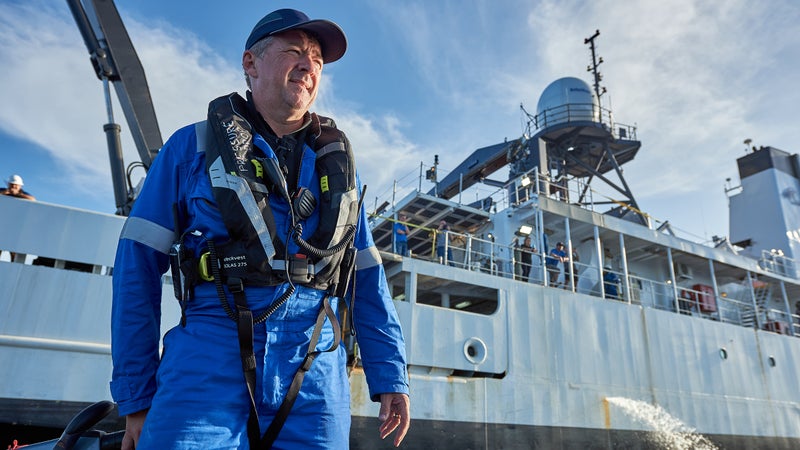
He’d landed in a heavily sedimented basin that was “completely and utterly flat.” No visible life stirred, though Jamieson would later point out the burrows of many reclusive creatures captured by video cameras. “It felt the most alien,” Vescovo said. “It was really cold, and I could just see the battery power being eaten away. It wasn’t welcoming. It didn’t want me there.”
He showed me some video that he’d shot on his phone, through the view ports. I found it hypnotic and dreamlike, beautiful in its own spooky way. The visibility was crystalline, and the bottom looked weirdly smooth, as though covered in a soft skin. It was actually a beige-gold sediment so fine that when it was disturbed by the thrusters, it billowed like smoke in the water. The sub’s lights cast rich twilight colors, azure and indigo ebbing to black. The Horizon Deep appeared to me like a cryptic story in an ancient language, a chapter of earth’s autobiography written on the seafloor.
Now, on the deck of the ship, after the miles at sea, the all-nighters spent working, the months away from family and friends, the tense business of submersible operations, the endless planning—it was time for the Five Deeps team to set all that down and cut loose for an evening. Jamieson was jamming on guitar with first mate Fraser Retson. In the background, I heard blenders whirring.
McCallum, circulating in a Hawaiian shirt, was pouring frozen margaritas. Lahey looked relaxed, laughing with his six-man Triton crew at a picnic table. The night was warm and humid, and the air smelled of rain and flowers. After a while people began singing. Vescovo got up and belted out “Desperado,” his ponytail slipping from its elastic. Then he added a verse of his own:
I’ve got the Five Deeps blues
Sitting on a bridge in Tonga
My battery’s on fire at 10,000 meters
And I’m just trying to get home
He finished to loud applause; someone handed him a margarita. Vescovo leaned back against the ship’s railing. Five Deeps was on the home stretch of its journey, but some interesting experiences still lay ahead. Eleven weeks from now, the Molloy Deep dive in the Arctic would go off seamlessly, and the team would celebrate by cruising through fjords for two days, watching polar bears cavorting and walruses lolling against a backdrop of snow-capped peaks. From there, the Pressure Drop sailed on to Edinburgh, then down to London, where Vescovo received a standing ovation after a presentation at the Royal Geographical Society.
But his victory lap was interrupted by a dash of controversy. James Cameron, who’d supported the expedition wholeheartedly, offering advice and exchanging e-mail with Vescovo along the way, spoke up from New Zealand, where he was working on three Avatar sequels. to the expedition’s newly announced claim that Vescovo had made the “deepest submarine dive in history” in the Challenger Deep, going 17 meters deeper than Cameron had. “For me, the science work is the most important part,” Cameron told me. “But I don’t think he went deeper. I don’t think you can go deeper.” The Challenger Deep is just not that bumpy, he said. “I think Victor and I went to the same place, which is a completely dead-ass flat plain.” Any variations in depth measurements, he added, fell within the typical margins of error.
Vescovo’s kid-like curiosity coexists with a mind that knows how to construct an aerospace factory and decipher raw intelligence on Al Qaeda.
Vescovo conceded nothing. “We assaulted the Mariana Trench with a level of technology—the sonar, three landers, multiple submarine dives—that we have very high confidence in our data,” he pointed out to the audience at the Royal Geographical Society. “His depth data probably are more accurate,” Cameron agreed, and then laughed. “My response to that is: Cool. That means I went deeper than I thought I did.”
“Look, I have enormous respect for the guy,” Vescovo would tell me later, sounding frustrated. “But it’s tough for me to just ignore my own data and make a scientific statement that, ‘Yeah, it’s completely flat.’ I’ve got all my instruments saying that’s not the situation, and I think it’s just as possible that we did find a deeper place. And you know, I don’t know what to tell him.”
In any case, all these dives were good news for the ocean, and none of this was any kind of finale. It was more like the end of the beginning. Vescovo had already announced his next expedition with the Limiting Factor. He wanted to go back to the Challenger Deep—he’d extended an invitation to Cameron to join him—and then off to explore more trenches along the Pacific Ring of Fire, a 25,000-mile belt of seismic mayhem full of deep-sea volcanoes. “That’s what’s so great about ocean exploration,” he told me in Nukualofa, taking a sip of his drink. “There’s still so much that’s unknown.” Plus, he added, “I’ve gotten hooked on it.” Behind him the lights from King Tupou’s palace shone. Vescovo looked out at the water and smiled. “We’ve had some fun. Isn’t that the point?” O
Susan Casey (), formerly an �����ԹϺ��� creative director and editor in chief at O, the Oprah Magazine, is the author of three books: , , and .



